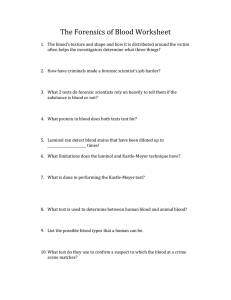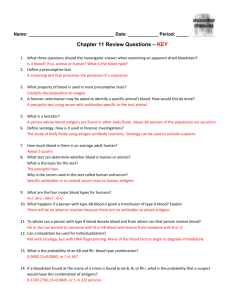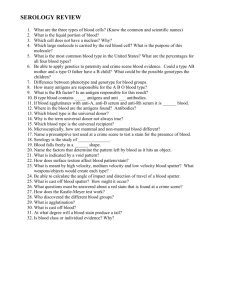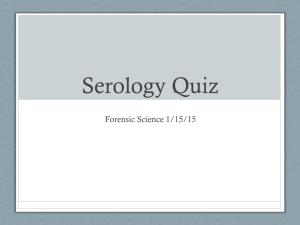blood
advertisement
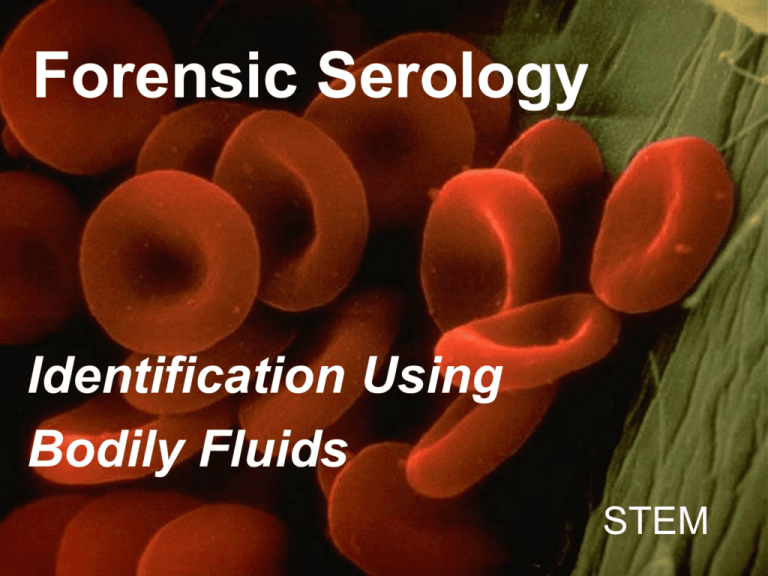
Forensic Serology Identification Using Bodily Fluids STEM Forensic Serology Serology – term used to describe a broad range of laboratory tests using reactions of blood serum and body fluid Forensic Serology The serology section of a forensic laboratory deals with the following: • blood typing • characterization of unknown blood • stain patterns for crime reconstruction • paternity testing • DNA identification techniques The Composition of Blood Blood is a mixture of many components: •cells •inorganic substances (salts) •enzymes •water •proteins The Composition of Blood • 55 % of blood content is plasma – mostly water and substances dissolved in it • Most of the solid materials are cells - red blood cells, RBCs (erythrocytes) - white blood cells, WBCs (leukocytes) Blood – Physical Characteristics • Adult ♂ contains 5-6L - Adult ♀ contains 4-5L • Temp is about 100.4 F – higher or lower than normal body T? • 5 times as viscous as water – more or less resistant to flow than water? – what accounts for its viscosity? • pH ranges from 7.35 – 7.45 (slightly alkaline) • Color ranges from scarlet (oxygenated blood) to a deep red (deoxygenated blood). Three questions that must be answered by the forensic investigator: 1) Is it blood? Benzidine Test Kastle-Meyer Test Hemastix (o-tolidine, TMB) Luminol Test 2) Is it human blood? Precipitin Test 3) Can it be associated with an individual? • Red blood cells contain Luminol hemoglobin (Hb) – for transporting oxygen, which is made of iron • Luminol reacts with iron and becomes visible under UV light Luminol Blood Antigens • On the surface of red blood cells are chemical structures (proteins) called antigens • Antigens allow a living system to recognize foreign substances • Antigens also have characteristics and can be used to identify individuals • Human red blood cells have more than 15 different antigen types, but we’ll focus on two Blood Typing Blood typing involves determination of the antigens present on an individual’s RBCs Blood Typing The two most common blood typing systems are the A-B-O and the Rh methods type A blood – contain “A” antigen on RBCs type B blood – contain “B” antigen on RBCs type AB blood – contains A & B antigens type O blood – contain no A or B antigens Rh+ blood – contains Rh antigen Rh- blood – no Rh antigen Blood Typing When blood encounters free oxygen (like in a cut), the blood clots, or agglutinates The clots can then be removed by the host system Blood Typing Human serum containing specific antibodies can be purchased Separately mix a drop of unknown blood sample with drop of each antiserum Reaction between blood and anti-serum No reaction between blood and anti-serum Blood Stain Patterns Dexter Blood Stain Pattern Video Clip Catching Killers - Blood Stains 101 -Video Clip Blood Stain Pattern Analysis Categories of Bloodstains: •Passive (dripping) •Transfer (smearing) •Projected Projected Bloodstains occur in shootings, trauma from blunt weapons, hacking, or slashing attacks. Projected Bloodstain Analysis Two Important Determinations: a. direction of spatter b. angle of impact with surface sin = (width drop / length drop) Forensic Characterization of Saliva Saliva is a mixture of many components: • 99% water • Mucin (protein helps in swallowing) • Amylase (enzyme to digest carbos) Cheek cells (good for DNA) Adults produce 1.0-1.5 liters of saliva/day and it is not uncommon at crime scenes (especially involving bite marks). Forensic Characterization of Saliva • A simple test for saliva involves mixing starch, iodine, and a sample of the presumed saliva together. • Starch and iodine are a deep blue color when mixed together. The amylase breaks down starch, however, and the color fades (takes about 15 mins @ 37 oC).
